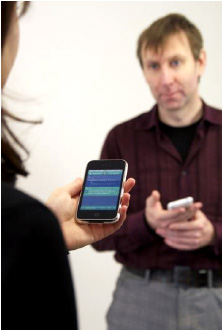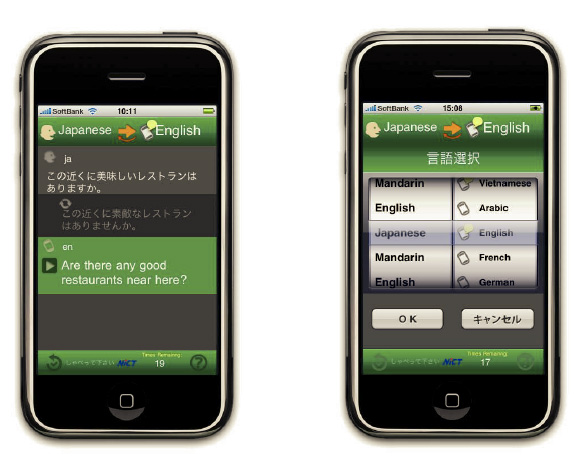Even in this borderless society, the language barrier is still a big challenge for borderless communication. To overcome this barrier, NICT has been working on the research and development on the speech-to-speech translation technology that enables real-time translation of a spoken dialog from one language to another.
Home > Press Release > Network-based Multilingual Speech-to-Speech Translation Covering 21 Languages, Ready for the Use on Smartphones
Network-based Multilingual Speech-to-Speech Translation Covering 21 Languages, Ready for the Use on Smartphones
The National Institute of Information and Communications Technology (President: Dr. Hideo Miyahara, hereinafter called as “NICT”) has been developing the multilingual speech and language processing technology in the framework of MASTAR Project, led by Dr. Satoshi Nakamura. Now we came to the stage to actualize the large-scale multilingual translation. You can input your speech in 6 languages (Japanese, English, Chinese, Vietnamese, Indonesian and Malay) and obtain translation results in 21 languages, out of which speech output is available in 6 languages (Japanese, English, Chinese, Vietnamese, Indonesian and Malay) while the other languages are shown in text. We are ready to provide this technology as a network-based service to be used on smartphones.

NICT has so far developed the interactive and real-time speech-to-speech translation technology for travel conversation in Japanese, English and Chinese. We succeeded in expanding its speech processing portion to cover 6 languages and its translation portion to cover 21 languages with our improved technology using multilingual speech and text corpora. The speech output is now available in 6 languages, 3 more languages (Vietnamese, Indonesian and Malay) than before, while the text output is in 21 languages (see Appendix). Furthermore, this technology is ready to be provided as a network-based service for the use on smartphones. You can use it on iPhoneTM, a popular gadget with more than 50 million users, all over the world via 3G or WiFi network.
Based on our speech-to-speech translation technology with speech input (recognition) and speech output (synthesis) in the 21 languages, which covers 80% of the world’s population, we will continue our effort for more multilingualization. In the meantime, this technology is expected to be open to the public, in this fiscal year, for the use with smartphones. For that purpose, we will proceed with feasibility study in the real field, problem analysis, and technical improvement, aiming for the full-scale practical use.
※ Please refer to the past release entitled “MOBILE WIRELESS ROUTER CONFORMING TO
Appendix

Left: Translation result Right: Language selection menu
| Speaker's language (Speech input) | ||||||
| Translated language | Japanese | English | Chinese (Simplified) |
Indonesian | Vietnamese | Malay |
| Japanese | S | S | S | S | S | |
| English | S | S | S | S | S | |
| Chinese (Simplified) | S | S | S | S | S | |
| Indonesian | S | S | S | S | S | |
| Vietnamese | S | S | S | S | S | |
| Malay | S | S | S | S | S | |
| Korean | T | T | T | T | T | T |
| Chinese (Traditional) | T | T | T | T | T | T |
| Thai | T | T | T | T | T | T |
| Hindi | T | T | T | T | T | T |
| Arabic | T | T | T | T | T | T |
| Danish | T | T | T | T | T | T |
| Geman | T | T | T | T | T | T |
| Spanish | T | T | T | T | T | T |
| French | T | T | T | T | T | T |
| Italian | T | T | T | T | T | T |
| Dutch | T | T | T | T | T | T |
| Portuguese | T | T | T | T | T | T |
| Russian | T | T | T | T | T | T |
| Tagalog | T | T | T | T | T | T |
| Brazilian Prtuguese | T | T | T | T | T | T |
For Technical Inquiries
Dr. Satoshi NAKAMURA
Director, MASTAR Project
Tel:0774-98-6304
E-mail: 












Public Relations
Sachiko HIROTA
Public Relations Office
Strategic Planning Department
TEL: 042-327-6923
E-mail: 

























